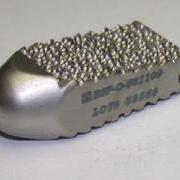September 22, 2010
|
Two cervical spinal spacers are textured with the Tecotex I104 pattern. |
Smooth surfaces are fine for tabletops or new cars. But to promote osseointegration and attach implants to native bone, a smooth surface is the last thing you want. And while roughening up implant surfaces may not seem difficult, traditional methods for doing so have several drawbacks. Striving to overcome these drawbacks, Tecomet has developed a chemical etching technique for creating rough surfaces that can promote on-growth and in-growth of bone tissue.
The Tecotex process produces a textured engineered surface on metallic 3-D objects. "Known as photochemical machining, this process is normally used for producing printed circuit boards and other applications," remarks Mark Amrich, Tecomet's vice president of manufacturing, etched products. "In this case, it prepares implant surfaces."
The process begins by coating raw metal sheet stock with photosensitive polymeric photoresist. Then, a negative or positive CAD image is printed onto the resist, and ultraviolet light cross-links the polymer and selectively bonds it to the metallic substrate. Using an aqueous solvent, the resist is removed from the unexposed areas, revealing the bare metallic substrate; the remaining resist is left in place to protect the underlying metal from chemical attack. Placed in a bath or in spray etching equipment, the sheet stock is finally subjected to chemicals that dissolve the exposed bare metal. "The result," Amrich says, "is a burr-free, stress-free, and repeatable process."
Tecomet's chemical etching method, according to Amrich, overcomes the limitations of using porous coated titanium beads and plasma sprays, which have been the preferred surface treatments for providing on-growth/in-growth surfaces on orthopedic medical implants. Porous coatings, for example, require high temperatures to sinter small titanium balls onto the surface of the implant. This process causes grain growth, which weakens the implant, Amrich notes. And while plasma sprays use lower temperatures, they require labor-intensive masking and can be difficult to control.
"In contrast, Tecotex is a low-temperature process that retains implants' mechanical properties," Amrich explains. "The texturing can thus be done after the implant is completely finished, thereby reducing process steps and increasing efficiency." The surface is also imaged onto the implant, enabling precise pattern placement and eliminating the need for additional masking, he adds.
The Tecotex process enables OEMs to choose a surface tailored for a specific medical device. Capable of texturing 0.001- to 0.100-in.-thick flat parts made from stainless-steel and titanium alloys, it can etch features as small as 50 µm onto the implant and control etch depths to within ±0.002 in.
Primarily used in the maxillofacial and neurocranial markets, Tecomet's etched implant devices are employed to repair fractures, cover bone voids, and reconstruct defects in the facial, mandibular, and cranial regions of the skull. "Our textured surfaces are particularly desirable for surgical implants," Amrich comments. "The engineered texture creates a series of peaks and valleys that promote bone on-growth." Grabbing onto the bone, the peaks' undercuts create good initial fixation, Amrich adds.
Tecomet
Wilmington, MA
www.tecomet.com
You May Also Like



